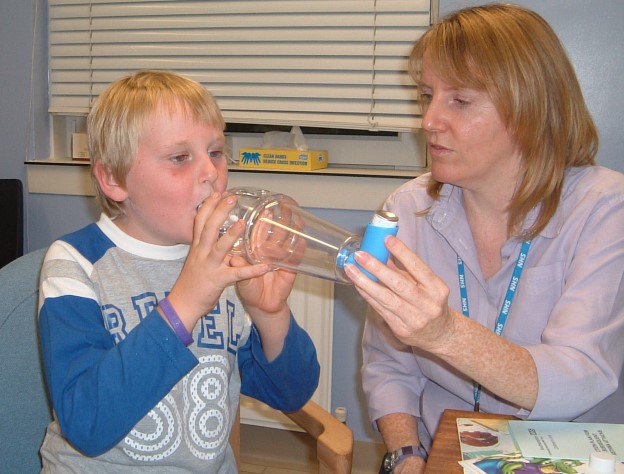

Asthma attack
If your child’s asthma suddenly gets much worse (asthma attack), they will require urgent treatment. Signs of an asthma attack include:
- Being very wheezy
- Having a tight chest
- Finding it hard to breath
- Being too breathless to speak is a sign of a severe asthma attack and needs emergency treatment
Looking after your child during an asthma attack
Your child may feel frightened if they are finding breathing difficult; try to remain calm, sit them upright and reassure them, and observe them closely.
The medicine in the blue inhaler should relieve their symptoms – always use a spacer device with “puffer” inhalers as this helps the medicine to reach the area of the lungs affected by asthma.
If you are concerned about your child’s symptoms please see the table below.
When should you worry?
If your child is:
- Too breathless to talk / eat or drink
- Has blue lips
- Having symptoms of cough/wheeze or breathlessness which are getting worse despite 10 puffs blue (salbutamol) inhaler every 4 hours
- Confused and drowsy
You need urgent help
Give the blue reliever (salbutamol) inhaler through a spacer device - 1 puff at a time every 60 seconds up to a maximum of 10 puffs. Repeat every 10 minutes until the ambulance arrives.
Keep child in upright position and reassure them
If your child is:
- Wheezing and breathless and blue (salbutamol) reliever inhaler 2-4 puffs is not lasting at least 4 hours
- Having a cough or wheeze/tight chest during the day and night
- Too breathless to run / play / do normal activities
You need to contact a your GP Surgery today
Increase blue (salbutamol) reliever inhaler 6-10 puffs every 4 hours
If your child starts to cough, wheeze or has a tight chest but can continue day to day activities
Give 2-4 puffs blue (salbutamol) reliever inhaler every 4 hours until symptoms improve
This guidance has been reviewed and adapted by healthcare professionals across the Black Country Integrated Care System.
After an asthma attack
Continue to monitor your child carefully and contact your GP Team if you are worried
Arrange a follow up review with your GP Team within 48 hours
Treatment over the next few days
Treatment over the next few days
Give the blue reliever (salbutamol) inhaler through a spacer device – 2-4 puffs as needed (1 puff at a time every 60 seconds) 4-6 hourly.
The dose and frequency can be reduced as your child gets better until they do not need the blue reliever inhaler any more than 2 times per week
Complete any courses of prescribed treatment such as oral steroids
Continue all other prescribed treatment such as a preventer inhaler (usually brown, orange or purple)
To download the asthma care plan to support your child's asthma click here for Asthma Care Plan.
If your child is feeling unwell then you need to make an urgent appointment with your GP Practice or Out of Hours.
What can you do to reduce the risk of your child having another asthma attack?
1) Children with poorly controlled asthma are much more likely to have an asthma attack compared to children whose asthma is well controlled.
Signs of poorly controlled asthma include your child having a regular cough at night (nocturnal cough), being wheezy or more breathless than other children when they run around (exertional dyspnoea) or using their reliever inhaler more often than expected.
Arrange to see your GP or asthma nurse if they are experiencing such symptoms.
2) It is vital that your child uses their inhalers correctly.
Your child’s asthma will not be controlled if their medicines are not getting into their lungs.
Choose appropriate sized spacer with mask or mouthpiece if child is over 3 years old.
- Shake the inhaler well and remove cap
- Fit the inhaler into the opening at the end of the spacer
- Place mask over the child's face or mouthpiece in their mouth ensuring a good seal
- Press the inhaler once and allow the child to take 5 slow breaths or slow count to 10 between each puff
- Remove the inhaler and shake between every puff. Wait 1 minute between puffs

Repeat steps 1-5 for subsequent doses.
Plastic spacers should be washed regularly as per manufacturer’s guidelines
For videos on using your child's inhaler and spacer correctly see Using your Inhaler
(Photo provided by IPCRG)
See your practice nurse or doctor if you are not sure whether your child is using their inhaler properly.
3) Avoid triggers where possible:
Although it is extremely difficult to avoid your child getting a viral infection or experiencing changes in the weather, you can reduce exposure to common irritants such as cigarette smoke. Even where adults smoke away from their children, smoke on their clothes and hair is likely to make their child’s asthma worse.
4) Your child should have an influenza immunisation every autumn.
Not only can flu trigger an asthma attack in your child, your child is more likely to experience severe influenza if they have asthma. Protect them by having them vaccinated every year. Click on this link for essential information on childhood vaccinations/immunisations.
Where should you seek help?
- If it is non-urgent, speak to your local pharmacist or health visitor.
- If your child has any of the above features, urgently see your GP. For an urgent out-of-hours GP appointment, call NHS 111.
- You should only call 999 or go your nearest A&E department in critical or life threatening situations.
Health visitors are nurses or midwives who are passionate about promoting healthy lifestyles and preventing illness through the delivery of the Healthy Child Programme. They work with you through your pregnancy up until your child is ready to start school.
Health Visitors can also make referrals for you to other health professionals for example hearing or vision concerns or to the Community Paediatricians or to the child and adolescent mental health services.
Contact them by phoning your Health Visitor Team or local Children’s Centre.
Sound advice
Health visitors also provide advice, support and guidance in caring for your child, including:
- Breastfeeding, weaning and healthy eating
- Exercise, hygiene and safety
- Your child’s growth and development
- Emotional health and wellbeing, including postnatal depression
- Safety in the home
- Stopping smoking
- Contraception and sexual health
- Sleep and behaviour management (including temper tantrums!)
- Toilet training
- Minor illnesses
For more information watch the video: What does a health visitor do?
Health visitors are nurses or midwives who are passionate about promoting healthy lifestyles and preventing illness through the delivery of the Healthy Child Programme. They work with you through your pregnancy up until your child is ready to start school.
Health Visitors can also make referrals for you to other health professionals for example hearing or vision concerns or to the Community Paediatricians or to the child and adolescent mental health services.
Contact them by phoning your Health Visitor Team or local Children’s Centre.
Sound advice
Health visitors also provide advice, support and guidance in caring for your child, including:
- Breastfeeding, weaning and healthy eating
- Exercise, hygiene and safety
- Your child’s growth and development
- Emotional health and wellbeing, including postnatal depression
- Safety in the home
- Stopping smoking
- Contraception and sexual health
- Sleep and behaviour management (including temper tantrums!)
- Toilet training
- Minor illnesses
For more information watch the video: What does a health visitor do?
School nurses care for children and young people, aged 5-19, and their families, to ensure their health needs are supported within their school and community. They work closely with education staff and other agencies to support parents, carers and the children and young people, with physical and/or emotional health needs.
Primary and secondary schools have an allocated school nurse – telephone your child’s school to ask for the contact details of your named school nurse.
There is also a specialist nurse who works with families who choose to educate their children at home.
Sound Advice
Before your child starts school your health visitor will meet with the school nursing team to transfer their care to the school nursing service. The school nursing team consists of a school nursing lead, specialist public health practitioners and school health staff nurses.
They all have a role in preventing disease and promoting health and wellbeing, by:-
- encouraging healthier lifestyles
- offering immunisations
- giving information, advice and support to children, young people and their families
- supporting children with complex health needs
Each member of the team has links with many other professionals who also work with children including community paediatricians, child and adolescent mental health teams, health visitors and speech and language therapists. The school health nursing service also forms part of the multi-agency services for children, young people and families where there are child protection or safeguarding issues.
School nurses care for children and young people, aged 5-19, and their families, to ensure their health needs are supported within their school and community. They work closely with education staff and other agencies to support parents, carers and the children and young people, with physical and/or emotional health needs.
Primary and secondary schools have an allocated school nurse – telephone your child’s school to ask for the contact details of your named school nurse.
There is also a specialist nurse who works with families who choose to educate their children at home.
Sound Advice
Before your child starts school your health visitor will meet with the school nursing team to transfer their care to the school nursing service. The school nursing team consists of a school nursing lead, specialist public health practitioners and school health staff nurses.
They all have a role in preventing disease and promoting health and wellbeing, by:-
- encouraging healthier lifestyles
- offering immunisations
- giving information, advice and support to children, young people and their families
- supporting children with complex health needs
Each member of the team has links with many other professionals who also work with children including community paediatricians, child and adolescent mental health teams, health visitors and speech and language therapists. The school health nursing service also forms part of the multi-agency services for children, young people and families where there are child protection or safeguarding issues.
If you’re not sure which NHS service you need, call 111. An adviser will ask you questions to assess your symptoms and then give you the advice you need, or direct you straightaway to the best service for you in your area.
Sound advice
Use NHS 111 if you are unsure what to do next, have any questions about a condition or treatment or require information about local health services.
For information on common childhood illnesses go to What is wrong with my child?
If you’re not sure which NHS service you need, call 111. An adviser will ask you questions to assess your symptoms and then give you the advice you need, or direct you straightaway to the best service for you in your area.
Sound advice
Use NHS 111 if you are unsure what to do next, have any questions about a condition or treatment or require information about local health services.
For information on common childhood illnesses go to What is wrong with my child?
A&E departments provide vital care for life-threatening emergencies, such as loss of consciousness, suspected heart attacks, breathing difficulties, or severe bleeding that cannot be stopped. If you’re not sure it’s an emergency, call 111 for advice.
Sound advice
A&E departments provide vital care for life-threatening emergencies, such as loss of consciousness, suspected heart attacks, breathing difficulties, or severe bleeding that cannot be stopped. If you’re not sure it’s an emergency, call 111 for advice.
